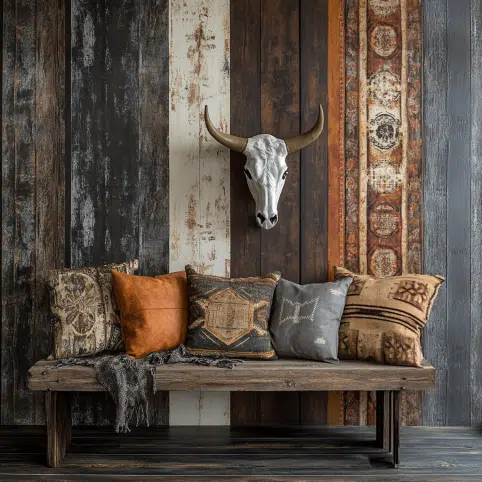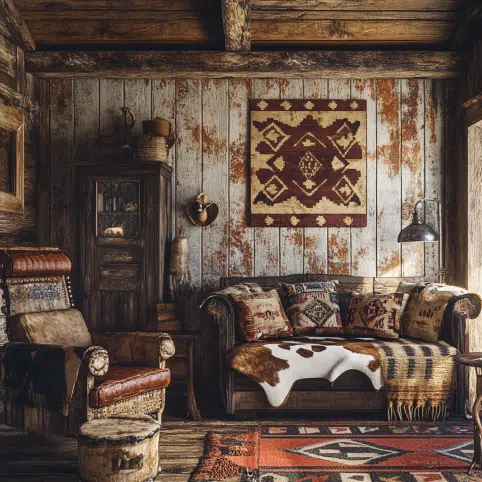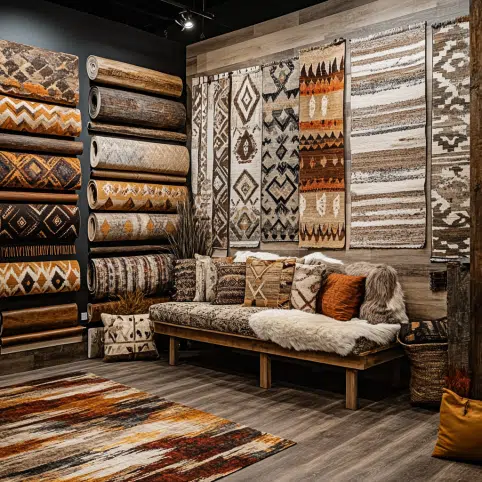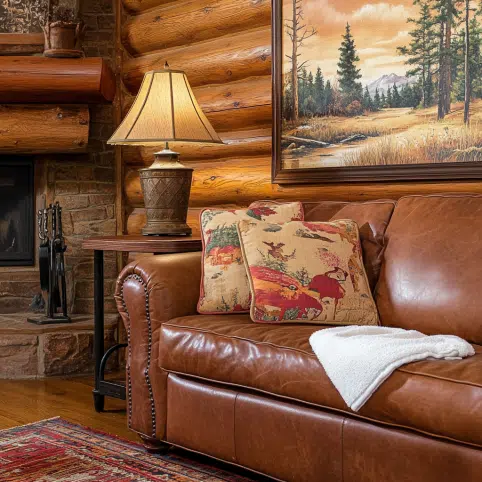Guide to Western Wallpaper
Rustic Charm for Every Room
The History and Evolution of Western Wallpaper in Interior Design
Western wallpaper has a rich and fascinating history that reflects the evolution of interior design and cultural influences over time. From its humble beginnings as a simple wall covering to its role as a key design element in rustic and country-style homes, Western wallpaper has continually evolved to meet changing tastes and design trends. Understanding the history and evolution of Western wallpaper not only highlights its enduring charm but also offers insight into how this design element has adapted to modern interiors while preserving its rustic roots.
The origins of Western wallpaper can be traced back to the early days of American frontier living. Settlers in the West sought to create warmth and comfort within their homes, often using practical and affordable materials to decorate their spaces. Early Western wallpaper designs were influenced by the natural surroundings and the rural lifestyle. Patterns often featured rustic motifs such as wood grain, stone textures, and botanical prints that reflected the landscapes of the American West. These designs were intended to bring a sense of the outdoors inside, creating a cozy and inviting atmosphere in homes that were otherwise built for function and durability.
As the American frontier expanded and settlers established more permanent dwellings, Western wallpaper designs began to incorporate more intricate patterns and higher-quality materials. In the late 19th and early 20th centuries, Western wallpaper evolved to include elements of Victorian design, blending rustic themes with ornate details. Floral prints, damask patterns, and even metallic accents began to appear in Western interiors, reflecting the growing influence of European design trends. However, these designs retained the earthy color palettes and natural motifs that remained true to Western aesthetics.
During the mid-20th century, Western wallpaper experienced a resurgence in popularity, especially during the post-war housing boom. As families moved into suburban homes, there was a renewed interest in traditional and nostalgic design elements. Western wallpaper became a popular choice for creating themed rooms and rustic spaces within modern homes. Designs during this period often featured imagery of cowboy life, horses, and Southwestern patterns, celebrating the rugged and adventurous spirit of the West. Log cabins, ranch-style homes, and country cottages commonly showcased Western wallpaper as a way to evoke a sense of heritage and connection to the land.
In recent decades, Western wallpaper has continued to evolve, blending traditional rustic motifs with contemporary design elements. Modern Western wallpaper often features updated versions of classic patterns, incorporating cleaner lines, minimalist designs, and more refined textures. For example, wood plank wallpaper now comes in realistic 3D prints, and stone-textured wallpapers offer a more polished look while maintaining their rustic appeal. Designers have also embraced neutral and muted color palettes, allowing Western wallpaper to fit seamlessly into a variety of interior styles, from farmhouse chic to modern rustic.

One of the most significant shifts in the evolution of Western wallpaper is the use of sustainable and eco-friendly materials. As environmental awareness has grown, manufacturers have developed wallpapers made from recycled materials, non-toxic inks, and biodegradable substrates. This shift has allowed Western wallpaper to maintain its connection to nature while aligning with modern values of sustainability and environmental responsibility. The focus on natural textures, such as reclaimed wood and weathered stone, has further strengthened the appeal of Western wallpaper in eco-conscious design.
Additionally, advancements in digital printing technology have expanded the possibilities for Western wallpaper designs. High-definition prints allow for incredibly realistic depictions of natural materials, making it easier than ever to achieve the look of authentic wood, stone, or leather walls without the cost and maintenance of real materials. Customizable designs have also become more accessible, enabling homeowners to personalize their Western wallpaper with unique patterns, colors, and images that reflect their individual style.
The versatility of Western wallpaper has allowed it to remain relevant in contemporary design. It is no longer limited to cabins and country homes; today, Western wallpaper can be found in urban lofts, modern farmhouses, and eclectic interiors. Its ability to evoke warmth, nostalgia, and a connection to nature makes it a popular choice for creating inviting and comfortable spaces. Whether used as an accent wall, throughout an entire room, or in small decorative touches, Western wallpaper continues to bring rustic charm and timeless appeal to modern homes.
Top Western Wallpaper Patterns to Create a Cozy and Rustic Atmosphere
Western wallpaper is a powerful design element that can instantly transform a space, bringing warmth, comfort, and a rustic charm that evokes the spirit of the American frontier. Whether you’re decorating a cozy cabin, a farmhouse, or simply want to add a touch of rustic elegance to a modern home, choosing the right Western wallpaper patterns is essential for creating a welcoming and authentic atmosphere. From natural textures to traditional motifs, Western wallpaper offers a wide variety of patterns that can suit different tastes while maintaining the cozy, rustic aesthetic that defines this style.
One of the most iconic and popular patterns in Western wallpaper is the wood grain design. This pattern mimics the look of natural wood planks, adding warmth and texture to walls without the need for actual wood installation. Wood grain wallpaper comes in a variety of finishes, including weathered barn wood, polished oak, and reclaimed timber, making it easy to create a rustic cabin feel or a farmhouse-inspired space. The natural tones and textures of wood grain Western wallpaper bring an organic element to a room, making it feel grounded and inviting. This pattern works exceptionally well in living rooms, bedrooms, and entryways where comfort and coziness are key.
Stone and brick patterns are another staple in Western wallpaper design. These patterns replicate the rugged textures of natural stone and aged brick, adding depth and character to a space. Stone-patterned Western wallpaper is perfect for creating an accent wall that feels rustic yet sophisticated. Whether it’s a rugged stacked stone look or a smoother river rock design, this type of wallpaper adds a sense of permanence and natural beauty to a room. Similarly, brick-patterned wallpaper can give a space the appearance of an old Western homestead or a rustic ranch house, blending seamlessly with wooden beams and vintage decor. Stone and brick wallpapers are ideal for spaces like fireplaces, dining areas, or home offices where a cozy, grounded ambiance is desired.

For those who want to introduce traditional Western motifs, Southwestern patterns in Western wallpaper are a timeless choice. Inspired by Native American and Mexican textiles, these patterns feature geometric designs, bold colors, and earthy tones. Southwestern wallpaper often includes motifs like diamonds, arrows, and zigzags in rich shades of terracotta, turquoise, and ochre. This pattern brings cultural depth and vibrant energy to a space, making it ideal for accent walls or even entire rooms. Southwestern-style Western wallpaper pairs beautifully with rustic wood furniture, leather accents, and woven textiles, creating a space that feels both cozy and culturally rich.
Cowhide and leather textures are also popular choices for Western wallpaper, especially for those looking to add a rugged, masculine touch to a room. Cowhide-patterned wallpaper mimics the look of authentic animal hides, bringing a sense of authenticity and frontier spirit into the home. Leather-textured wallpaper offers a more refined but equally rustic feel, providing a tactile element that adds warmth and sophistication. These patterns work well in dens, home offices, or man caves, where comfort and rustic elegance are equally important. Paired with dark wood furniture and metal fixtures, cowhide and leather Western wallpaper can create a luxurious yet grounded space.
Floral and botanical patterns in muted, earthy tones offer a softer approach to Western wallpaper while still embracing rustic charm. These designs often feature wildflowers, prairie grasses, and desert plants that reflect the natural beauty of the Western landscape. Botanical Western wallpaper is ideal for creating a calming and cozy atmosphere in bedrooms, reading nooks, or bathrooms. Soft floral patterns can balance the more rugged elements of Western decor, bringing a touch of romance and tranquility to rustic spaces.
For a more playful and thematic approach, cowboy and rodeo-inspired wallpaper offers a direct nod to Western heritage. Designs featuring cowboy hats, boots, lassos, and horse silhouettes can add personality and character to a space. This type of Western wallpaper is perfect for themed rooms, children’s bedrooms, or entertainment spaces where a sense of fun and adventure is desired. These patterns celebrate the adventurous and free-spirited nature of Western living while maintaining a cozy and welcoming vibe.
Lastly, plaid and checkered patterns are timeless classics in Western wallpaper design. These patterns, often associated with flannel shirts and rustic cabins, evoke feelings of warmth and comfort. Plaid wallpaper in shades of red, green, or brown adds a traditional, homely feel that pairs perfectly with wooden furniture and vintage decor. This pattern works well in kitchens, dining rooms, or bedrooms where a cozy, lived-in atmosphere is desired.
How to Choose the Perfect Western Wallpaper for Your Home Decor?
Choosing the perfect Western wallpaper for your home décor requires thoughtful consideration of style, color, pattern, and texture to create a space that feels warm, inviting, and authentically rustic. Western wallpaper can transform any room by adding charm, character, and a connection to nature. Whether you want to design a cozy farmhouse kitchen, a rustic cabin living room, or simply introduce Western elements into a modern space, selecting the right Western wallpaper involves balancing aesthetics and functionality to suit your home’s personality.
The first step in choosing the perfect Western wallpaper is to identify the overall design theme you want to achieve. Western décor covers a wide range of styles, from rugged cowboy and ranch-inspired designs to Southwestern and rustic farmhouse looks. If you prefer a more traditional Western aesthetic, consider Western wallpaper with motifs like wood grain, stone textures, or vintage cowboy imagery. For a more Southwestern feel, wallpaper featuring geometric patterns, desert landscapes, or earthy tones can create a vibrant and culturally rich atmosphere. Understanding your design goals will help narrow down the wallpaper choices and ensure that it complements your existing décor.
Color plays a crucial role in selecting Western wallpaper, as it sets the tone for the entire space. Earthy tones are the foundation of Western design, reflecting the natural landscapes of the American West. Warm shades of brown, beige, terracotta, and rust can create a cozy and grounded ambiance. Deep reds, burnt oranges, and muted yellows add vibrancy while still maintaining a rustic feel. If you prefer a more neutral palette, softer shades like cream, taupe, and light gray can make the room feel open and airy while providing a subtle Western touch. The key is to choose colors that not only fit the Western theme but also harmonize with your furniture and accessories.
The pattern and design of Western wallpaper should reflect the atmosphere you want to create. Wood plank designs, stone textures, and distressed finishes can give a room a natural and rugged look, perfect for creating a cabin-like environment. Southwestern-inspired patterns with bold geometric shapes and earthy colors can bring energy and cultural richness to a space. For a softer and more romantic take on Western décor, floral and botanical prints in muted tones can add a touch of elegance while still honoring rustic themes. Cowhide, leather, and plaid patterns are also popular choices for adding warmth and authenticity. Choosing the right pattern depends on the room’s size and function—larger, bolder patterns work well in spacious areas, while smaller, more subtle designs suit compact or intimate spaces.
Texture is another important factor to consider when selecting Western wallpaper. Adding texture to walls enhances the rustic feel of a room, making it more inviting and visually interesting. Wallpapers that mimic the look and feel of wood, stone, or leather add depth and dimension, creating a more immersive Western experience. For a more refined rustic look, consider wallpapers with linen or canvas textures in warm, earthy tones. The texture of the wallpaper should complement the room’s furnishings and finishes. For example, pairing a textured wood wallpaper with leather furniture and metal fixtures can create a balanced and cohesive Western-inspired space.

The functionality of the room should also guide your choice of Western wallpaper. High-traffic areas, such as entryways, hallways, and family rooms, may benefit from more durable and washable wallpaper materials to withstand daily wear and tear. Vinyl-coated or scrubbable wallpapers are practical choices for these spaces. In contrast, bedrooms or reading nooks may allow for more delicate wallpapers with soft textures and intricate patterns. Considering how the room is used will help determine the best type of Western wallpaper for long-lasting style and durability.
Lighting is another factor that can influence how Western wallpaper appears in a space. Natural and artificial light can change the perception of colors and textures throughout the day. In rooms with ample natural light, deeper, richer wallpaper colors can create a cozy and intimate feel. In darker rooms, lighter shades or wallpapers with reflective finishes can help brighten the space. It’s helpful to test wallpaper samples under different lighting conditions to ensure the chosen design maintains its desired look and feel.
Additionally, it’s important to consider how Western wallpaper will interact with your existing furniture and décor. If your furniture and accessories are already bold and patterned, a more subtle or solid-textured Western wallpaper can balance the room without feeling overwhelming. On the other hand, if your furnishings are more neutral, a bold and intricate Western wallpaper pattern can become a statement feature. Blending wallpaper with other elements like rustic wood furniture, metal accents, and natural fabrics will help create a cohesive and well-balanced Western-inspired space.
Finally, accent walls are a great way to introduce Western wallpaper without committing to covering an entire room. Applying Western wallpaper to one wall can create a striking focal point while keeping the space balanced. This approach works well in bedrooms behind the headboard, in living rooms behind the sofa, or even in dining rooms to highlight a feature wall. Accent walls allow you to experiment with bold patterns and textures while maintaining versatility in the room’s design.
Creative Ways to Style and Maintain Western Wallpaper for Long-Lasting Appeal
Styling and maintaining Western wallpaper in your home is key to preserving its rustic charm and ensuring it continues to enhance your space for years to come. Western wallpaper, known for its earthy tones, rugged textures, and nature-inspired patterns, can transform a room into a warm, inviting environment. However, to maximize its aesthetic appeal and longevity, it’s important to approach both styling and maintenance thoughtfully. By combining creative styling techniques with proper care, Western wallpaper can remain a striking feature that complements your home’s décor for the long term.
One of the most effective ways to style Western wallpaper is to balance it with complementary décor. Western wallpaper often features bold patterns and rich textures, such as wood grain, stone finishes, or Southwestern motifs. To highlight these designs without overwhelming the space, it’s important to pair the wallpaper with furniture and décor that enhances its natural beauty. Rustic wood furniture, leather upholstery, and metal accents in iron or bronze work beautifully with Western wallpaper, creating a cohesive and grounded look. Soft textiles like wool throws, woven rugs, and linen curtains can soften the boldness of the wallpaper, adding warmth and comfort to the space.
Layering textures is another creative way to style Western wallpaper. Since Western wallpaper often emphasizes natural textures, layering similar materials in the room can create depth and visual interest. For example, pairing a wood plank wallpaper with reclaimed wood shelves or a stone-patterned wallpaper with a stone fireplace surround adds authenticity and dimension. Incorporating natural elements like potted plants, antler décor, or woven baskets can further enhance the rustic feel. This layered approach makes the space feel thoughtfully designed and cozy.

Accent walls are a strategic way to style Western wallpaper, especially in rooms where full coverage might feel too intense. Using Western wallpaper on a single feature wall allows it to become a focal point without dominating the entire room. A wood-textured wallpaper behind a bed in a bedroom, or a bold Southwestern pattern on a wall in the living room, can create visual interest and set the tone for the space. This approach allows you to enjoy the character of Western wallpaper while maintaining balance with neutral or lightly textured walls.
Blending Western wallpaper with modern or eclectic elements can give it a fresh and updated look. While Western wallpaper is traditionally associated with rustic design, pairing it with modern furniture, minimalist lighting, or contemporary art can create a stylish contrast. For instance, using a rugged wood grain wallpaper alongside sleek metal furniture can blend rustic and industrial styles, making the room feel current yet cozy. Mixing Western wallpaper with eclectic décor allows for creative expression while keeping the space warm and inviting.
Maintaining the appearance of Western wallpaper is just as important as styling it. Proper care ensures that the wallpaper remains vibrant and intact for years. One of the most basic yet effective maintenance tips is to regularly clean the wallpaper to prevent dust and dirt buildup. Using a soft microfiber cloth or a vacuum with a brush attachment can help gently remove dust without damaging the surface. For washable Western wallpaper, a damp cloth with mild soap can be used to spot clean stains, but it’s important to test a small area first to avoid discoloration.
Protecting Western wallpaper from direct sunlight is essential for preserving its color and texture. Prolonged exposure to sunlight can cause the rich tones of the wallpaper to fade over time. Installing window treatments like curtains, blinds, or UV-protective window films can help shield the wallpaper from harsh sunlight. Additionally, rearranging wall décor or furniture periodically can ensure even exposure and prevent certain areas from fading faster than others.
Controlling the humidity and moisture levels in the room is also crucial, especially in areas like kitchens and bathrooms. Excess moisture can cause wallpaper to peel, bubble, or develop mold. Using dehumidifiers, exhaust fans, or moisture-resistant wallpaper materials can help prevent these issues. For high-traffic areas or rooms prone to spills, selecting durable, washable Western wallpaper can provide added protection against wear and tear.
Repairing minor damage promptly can prevent small issues from becoming larger problems. If the wallpaper begins to peel at the edges, applying a small amount of wallpaper adhesive can secure it back in place. For small tears or scratches, patching the area with a matching piece of wallpaper or using touch-up kits can restore the wallpaper’s seamless look. Addressing these issues quickly helps maintain the wallpaper’s overall appearance.
Finally, rotating decorative elements in the room can keep the styling of Western wallpaper fresh and engaging. Swapping out seasonal décor, rearranging furniture, or adding new art pieces can breathe new life into the space and allow the wallpaper to adapt to different design themes throughout the year. This flexibility keeps the room feeling dynamic and prevents the décor from becoming stagnant.
We invite you to visit our pages on 1A Group
For more information visit 1awallpaper.com
